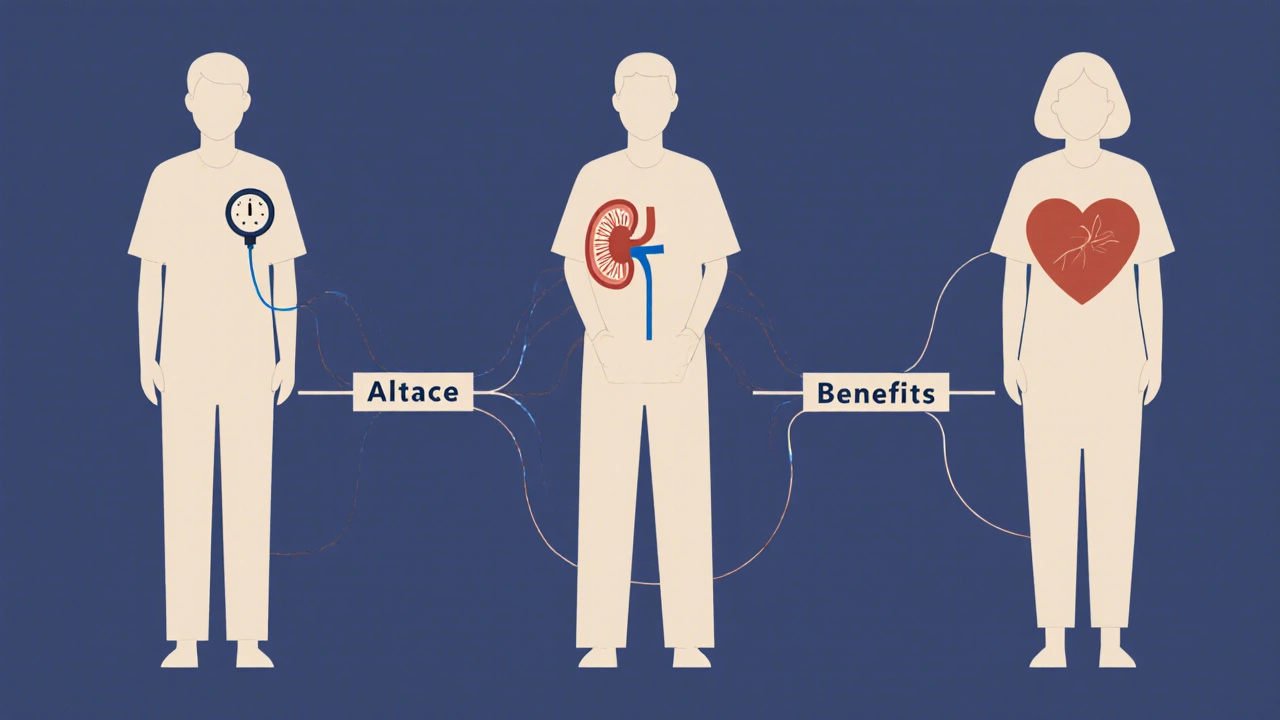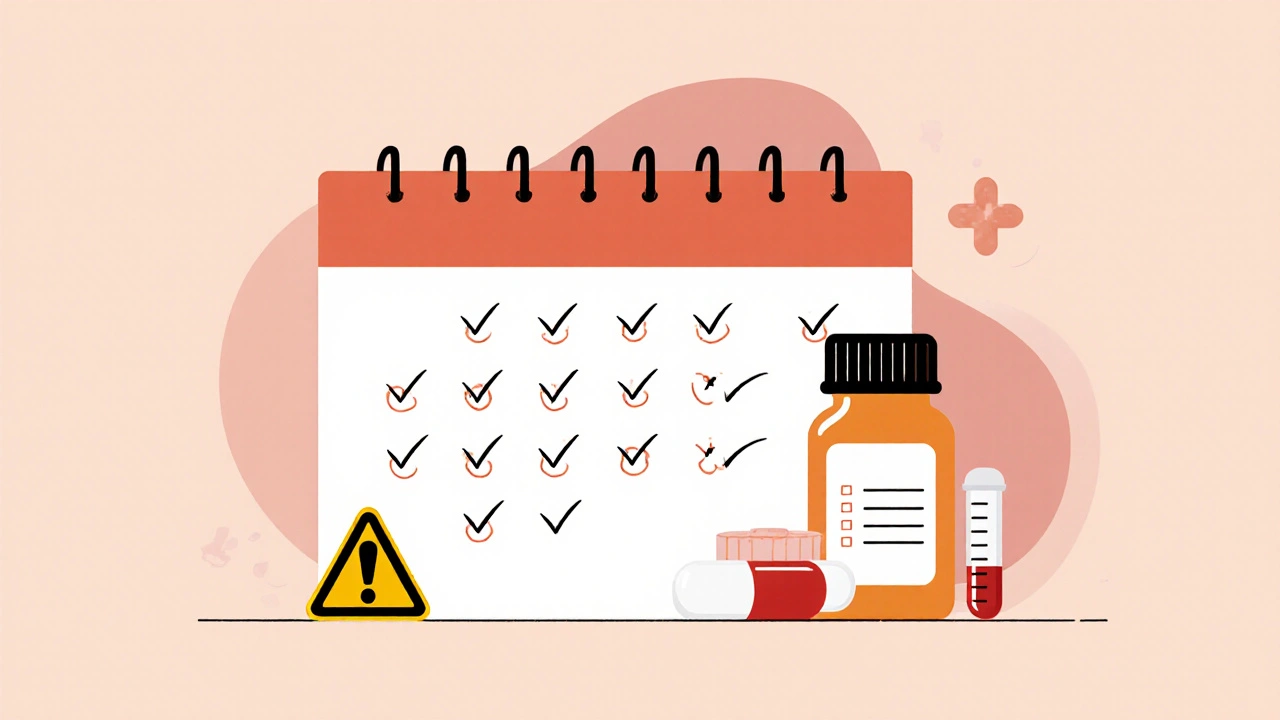Altace is a brand name for the drug ramipril, a medication used primarily to treat high blood pressure and improve survival after a heart attack. It’s also prescribed to slow kidney damage in people with diabetes and to reduce the risk of heart attack, stroke, or death in certain high-risk adults. If you’ve been prescribed Altace, you’re probably wondering how it works, what to expect, and whether it’s safe for you. This isn’t a drug that just lowers numbers on a chart-it changes how your body handles stress on the heart and blood vessels. Here’s what actually matters.
How Altace Works in Your Body
Altace belongs to a class of drugs called ACE inhibitors. ACE stands for angiotensin-converting enzyme. This enzyme normally turns a substance in your blood called angiotensin I into angiotensin II, which tightens blood vessels and raises blood pressure. Altace blocks that enzyme. When it’s blocked, blood vessels relax and widen. That lowers blood pressure and reduces the workload on your heart.
That’s the simple version. The real impact shows up in long-term outcomes. In the HOPE study, which tracked over 9,000 high-risk patients for five years, those taking ramipril had a 22% lower risk of heart attack, stroke, or death from cardiovascular causes compared to those on a placebo. That’s not a small benefit. It’s the kind of result that changes clinical guidelines.
Altace doesn’t just treat symptoms. It changes the course of disease. For people with diabetes and early kidney damage, it slows the decline in kidney function. For those who’ve had a heart attack, it reduces scarring and remodeling of the heart muscle. That’s why doctors don’t just prescribe it for high blood pressure-they use it to protect the heart and kidneys over time.
Who Takes Altace and Why
Altace isn’t for everyone. It’s typically prescribed for three main groups:
- People with high blood pressure (hypertension), especially if they also have diabetes or heart disease
- Patients who’ve had a heart attack and are at risk for future heart problems
- Individuals with type 2 diabetes and signs of kidney damage (like protein in the urine)
It’s not usually the first choice for young, healthy people with mild hypertension. Doctors often start with lifestyle changes or cheaper generics like lisinopril. But if you have multiple risk factors-say, high blood pressure plus obesity and a family history of heart disease-Altace becomes a key part of your protection plan.
One thing patients often don’t realize: Altace is used off-label for heart failure too. It’s not FDA-approved specifically for that, but it’s commonly prescribed because it reduces fluid buildup and improves heart function. If you’ve been told your heart is “weakening,” Altace might be part of why your symptoms are getting better.
Dosing and How to Take It Correctly
Altace comes in tablets: 1.25 mg, 2.5 mg, 5 mg, and 10 mg. The starting dose is usually low-1.25 mg or 2.5 mg once a day. Your doctor will slowly increase it based on your blood pressure response and kidney function. Most people end up on 5 mg to 10 mg daily.
You take it once a day, with or without food. But consistency matters. Take it at the same time every day. If you forget a dose, take it as soon as you remember-unless it’s close to your next dose. Then skip the missed one. Don’t double up.
It can take up to two weeks for your blood pressure to drop noticeably. Don’t assume it’s not working if you don’t feel different. That’s normal. The benefit isn’t about how you feel-it’s about what’s happening inside your arteries and heart.
Some people are prescribed a higher dose after a heart attack. In those cases, doctors start low-often 2.5 mg-and increase over several weeks. Going too fast can cause a dangerous drop in blood pressure.
Side Effects You Should Watch For
Most people tolerate Altace well. But side effects happen. Here’s what to look out for:
- Dry cough-This is the most common side effect. It’s not dangerous, but it can be annoying. About 1 in 10 people get it. If it’s keeping you up at night, talk to your doctor. You might switch to a different class of drug.
- Dizziness or lightheadedness-Especially when standing up. This is usually from low blood pressure. Drink water, stand slowly, and avoid alcohol. If you faint, call your doctor.
- High potassium levels-Altace can cause potassium to build up. If you’re eating a lot of bananas, spinach, or salt substitutes, your levels might rise. Your doctor will check your potassium with blood tests every few months.
- Swelling (angioedema)-Rare, but serious. If your face, lips, tongue, or throat swell up, stop taking Altace and get emergency help. This can happen even after years of use.
- Low blood pressure-More likely if you’re dehydrated, on a diuretic, or have kidney disease.
Don’t ignore these signs. A cough might seem minor, but if it’s persistent, it could mean you need a different medication. Swelling is a medical emergency. High potassium can cause heart rhythm problems. These aren’t just side effects-they’re warning signs.

What You Should Avoid
Altace interacts with a few things you might not expect:
- NSAIDs-Ibuprofen, naproxen, and other painkillers can reduce Altace’s effect on blood pressure and hurt your kidneys. Use acetaminophen instead if you need pain relief.
- Potassium supplements-Unless your doctor tells you to take them, avoid them. Same with salt substitutes that contain potassium.
- Diuretics-If you’re on water pills, your doctor will monitor you closely. The combination can drop your blood pressure too much.
- Alcohol-It lowers blood pressure too. Mixing it with Altace can make you dizzy or faint.
Also, don’t take Altace if you’re pregnant. It can cause serious harm to the developing baby-kidney damage, low amniotic fluid, even death. If you’re planning a pregnancy or think you might be pregnant, tell your doctor right away.
Alternatives to Altace
Not everyone can take ACE inhibitors. If you have a persistent cough, high potassium, or angioedema, your doctor might switch you to another drug:
- ARBs-Like losartan or valsartan. These work similarly but rarely cause cough. Often the first alternative.
- Calcium channel blockers-Amlodipine is common. Good for blood pressure, no cough risk.
- Thiazide diuretics-Hydrochlorothiazide. Often used with other drugs, not alone for high-risk patients.
Some people ask, “Why not just use a cheaper generic?” Ramipril (the generic version of Altace) is widely available and costs less than $10 a month at most pharmacies. Many doctors prescribe the generic unless there’s a specific reason to use the brand. Altace isn’t better-it’s the same drug.
Monitoring and Long-Term Use
Altace isn’t a drug you take for a few weeks and stop. It’s usually a lifelong medication. That means regular checkups matter.
Your doctor will want to check:
- Blood pressure (every few weeks at first, then every 3-6 months)
- Kidney function (creatinine and eGFR blood tests)
- Potassium levels
If your kidney function drops more than 30% after starting Altace, your doctor may adjust the dose or stop it. That doesn’t mean you’re failing-it’s a sign your kidneys are sensitive to the change in blood pressure. It’s common and manageable.
Many people stay on Altace for years without issues. But if you’re over 65, have diabetes, or have heart failure, you need more frequent monitoring. Older adults are more sensitive to blood pressure drops and kidney changes.

What to Do If You Want to Stop
Never stop Altace on your own. Stopping suddenly can cause your blood pressure to spike, increasing your risk of heart attack or stroke. If you’re having side effects, talk to your doctor. They can help you taper off safely or switch to another medication.
Some people stop because they feel fine. But feeling fine is exactly why you’re still on it. Altace is working. Stopping it means your heart and kidneys go back to being under stress.
Frequently Asked Questions
Is Altace the same as ramipril?
Yes. Altace is the brand name for ramipril. The generic version works the same way, costs less, and is just as effective. Most people are switched to the generic unless there’s a specific reason to stay on the brand.
Can I take Altace with other blood pressure meds?
Yes, but only under a doctor’s supervision. It’s common to combine Altace with a diuretic or calcium channel blocker if one drug isn’t enough. But never mix it with other ACE inhibitors or ARBs-that can raise the risk of kidney damage and high potassium.
Does Altace cause weight gain?
No, Altace doesn’t cause weight gain. In fact, some people lose a little weight because it reduces fluid retention. If you’re gaining weight while on Altace, it’s likely due to diet, lack of movement, or another medication.
How long does it take for Altace to start working?
You might see a drop in blood pressure within a week, but full benefits-especially for heart and kidney protection-take weeks to months. Don’t judge effectiveness by how you feel. Blood tests and follow-ups tell the real story.
Can I drink grapefruit juice while taking Altace?
Yes. Unlike some blood pressure drugs, Altace doesn’t interact with grapefruit juice. You can drink it safely. But avoid alcohol-it can lower your blood pressure too much.
Next Steps If You’re on Altace
If you’re taking Altace, here’s what to do next:
- Set a daily reminder to take it at the same time.
- Write down any side effects-especially cough, dizziness, or swelling-and bring them to your next appointment.
- Ask your doctor for a copy of your latest kidney and potassium blood test results.
- Keep a list of all your medications, including over-the-counter ones, and review it with your doctor every six months.
- If you’re over 65 or have diabetes, make sure you’re getting blood tests every 3-6 months.
Altace isn’t a magic pill. It’s a tool. Used right, it gives you years of protection. Used wrong-or ignored-it can leave you vulnerable. The goal isn’t just to take it. It’s to understand why you’re taking it-and how it’s keeping you safe.


Written by Felix Greendale
View all posts by: Felix Greendale